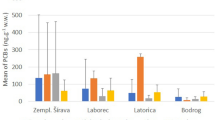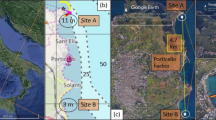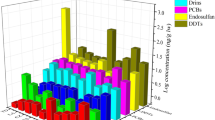Abstract
A SURVEY of the residues of organochlorine insecticides in the marine environment of north-east England and south-east Scotland in 1965 and 1966 showed that dieldrin and pp′-DDE (a metabolite of DDT) occurred inthe highest amounts1. The highest concentrations of residues were found in tissues and eggs of the shag and cormorant (Phalacrocorax aristotelis and P. carbo), with, for example, the eggs of the former possessing on average almost 1 p.p.m. of dieldrin and about 2 p.p.m. of pp′-DDE. All other organochlorine insecticides including DDT were present at concentrations of less than 0.02 p.p.m. As a result of this survey it was concluded that shags' eggs were the most suitable material for continuing the monitoring of residues in that environment. The criteria used in selecting the indicator species were, first, that the concentration in the indicator should be sufficiently large to allow changes to be readily detected; second, that the movement of the organism from which the sample was to be taken should be restricted to the area under study; third, that the diet (and source of contamination) should be known; fourth, that the relationship between variations in age of the organism and the concentration of insecticide should have been determined.
This is a preview of subscription content, access via your institution
Access options
Subscribe to this journal
Receive 51 print issues and online access
$199.00 per year
only $3.90 per issue
Buy this article
- Purchase on Springer Link
- Instant access to full article PDF
Prices may be subject to local taxes which are calculated during checkout
Similar content being viewed by others
References
Robinson, J., Richardson, A., Crabtree, A. N., Coulson, J. C., and Potts, G. R., Nature, 214, 1307 (1967).
Robinson, J., Biological Impact of Pesticides in the Environment (edit. by Gillett, J. W.) (Oregon State University, in the press).
Potts, G. R., J. Animal Ecol., 38, 53 (1969).
Coulson, J. C., Potts, G. R., Deans, I. R., and Fraser, S. M., Brit. Birds, 61, 381 (1968).
Richardson, A., Robinson, J., Crabtree, A. N., and Baldwin, M. K., Pesticide Monitoring J., 4, 169 (1971).
Potts, G. R., Nature, 217, 1282 (1968).
Ministry of Technology, Report of the Government Chemist, 1969 (HMSO, London, 1970).
Abbott, D. C., Goulding, R., and Tatton, J. O'G., Brit. Med. J., 3, 146 (1968).
Robinson, J., and Roberts, M., Food Cosmet. Toxicol., 7, 501 (1969).
McGill, A. E. J., Robinson, J., and Stein, M., Nature, 221, 761 (1969).
Lockie, J. D., Ratcliffe, D. A., and Balharry, R., J. Appl. Ecol., 6, 381 (1969).
Harrison, H. L., Loucks, O. L., Mitchell, J. W., Parkhurst, D. F., Tracy, C. R., Watts, D. G., and Yannacone, jun. V. J., Science, 170, 503 (1970).
Author information
Authors and Affiliations
Rights and permissions
About this article
Cite this article
COULSON, J., DEANS, I., POTTS, G. et al. Changes in Organochlorine Contamination of the Marine Environment of Eastern Britain monitored by Shag Eggs. Nature 236, 454–456 (1972). https://doi.org/10.1038/236454a0
Received:
Issue Date:
DOI: https://doi.org/10.1038/236454a0
This article is cited by
-
Seabirds as monitor organisms of contaminants along the German North Sea coast
Helgoländer Meeresuntersuchungen (1989)
Comments
By submitting a comment you agree to abide by our Terms and Community Guidelines. If you find something abusive or that does not comply with our terms or guidelines please flag it as inappropriate.



